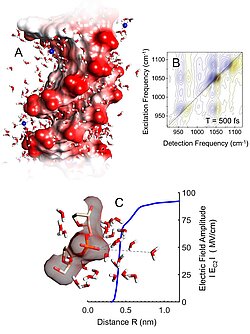DNA molecules are the carrier of genetic information and form a double helix structure in their native aqueous environment. This structure consists of two opposite twisted strands of nucleotides (Fig. 1A). An alternating arrangement of negatively charged phosphate groups and polar sugar units forms the backbone of the double helix structure which interacts directly with the surrounding water molecules. The overall negative charge of the double helix is compensated for by positively charged counterions such as sodium ions which in an aqueous environment are located in direct proximity to the DNA surface. The interaction of the electric dipoles of water molecules with the charges of the counterions and phosphate groups as well as the polar units generates electric fields at the DNA surface. Such fields are being discussed in a highly controversial way, even after decades of intense research, reflecting the structural complexity of this many-body system and its thermal fluctuations on short time scales.
Ultra-strong, ultra-fast and local: water induces electrical fields at the DNA surface
Fig. 1: (A) Surface of a DNA double helix. The twisted strands of the helix are represented by oxygen atoms (red) of the phosphate groups. Counterions are shown in blue, the small angled structures are water molecules. (B) Two-dimensional infrared spectrum of the DNA backbone. Nonlinear vibrational signals are plotted as a function of excitation and detection frequency. The lineshapes of the resonances on the diagonal (identical excitation and detection ferquency) are directly influenced by fluctuating electric fields. The off-diagonal signals originate from couplings between different backbone vibrations. (C) Time-averaged electric field (blue) as a function of the distance from the DNA surface. Water molecules in the first layer (around 0.4 nm) generate approximately 70% of the total field, the second water layer contributes some 20%.
Scientists from the Max-Born-Institute in Berlin have now succeeded for the first time in determining the strength, range, and ultrafast dynamics of electric fields at a native DNA surface. In a recent paper published in the Journal of Physical Chemistry Letters, they report how vibrations of the backbone of native salmon DNA serve as probes for mapping electric interactions in space and time. Electric fields at the surface directly influence the shape and dynamics of vibrational resonances which are recorded in real-time on the femtosecond time scale (1 fs = 10-15) s by a method referred to as two-dimensional infrared spectroscopy (Fig. 1B). The water content of the DNA samples has been varied in a systematic way to discern different contributions to the fluctuating electric fields at the DNA surface.
The experiments and a detailed theoretical analysis performed in parallel show that water molecules in the first two layers at the DNA surface generate an extremely strong electric field whereas the ionic groups and outer water layers play a minor role. The spatial range of the field is approximately 1 nm, its strength reaches values up to 100 megavolts/cm (hundred million volts per centimeter) as shown in Fig. 1C. Thermal motions of the water molecules result in field fluctuations of 25 MV/cm on a 300 fs time scale. The time scale of fluctuations demonstrates a hindrance of water motions due to the coupling to the corrugated DNA surface and a slowing down compared to neat water. This new quantitative insight is important for understanding the key role of water and its dynamics at biological interfaces such as charged cell membranes and the surface of proteins.
Search publications of MBI
Publications since 2025
